1993 CHEVROLET LUMINA brakes
[x] Cancel search: brakesPage 139 of 324
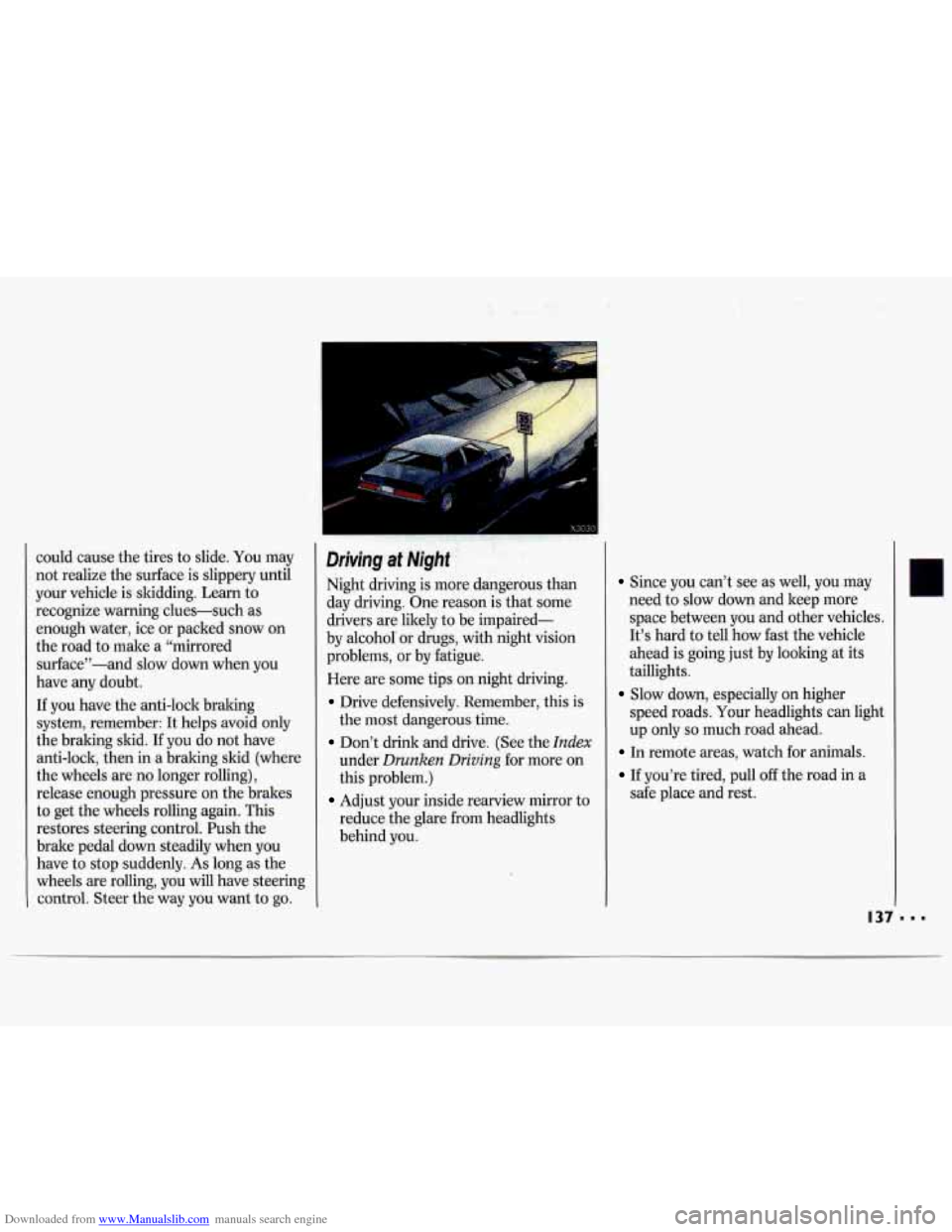
Downloaded from www.Manualslib.com manuals search engine -.,.. -
could cause the tires to slide. You may
not realize the surface is slippery until
your vehicle is skidding. Learn to
recognize warning clues-such as
enough water, ice or packed snow on
the road to make a “mirrored
surface”-and slow down when you
have any doubt.
If you have the anti-lock braking
system, remember: It helps avoid only
the braking
skid. If you do not have
anti-lock, then
in a braking skid (where
the wheels are no longer rohg),
release enough pressure on the brakes
to get the wheels rolling again.
This
restores steering control. Push the
brake pedal down steadily when
you
have to stop suddenly. As long as the
wheels are rolling, you will have steering
control. Steer the way you want to
go.
-
X3030 , , -;. - ., ,
Driving. at Might
Night driving is more dangerous than
day driving. One reason is that some
drivers are likely to be impaired-
by alcohol or drugs, with night vision
problems,
or by fatigue.
Here are some tips on night driving.
Drive defensively. Remember, this is
the most dangerous time.
Don’t drink and drive. (See the Index
under Drunken Driving for more on
this problem.)
Adjust your inside rearview mirror to
reduce the glare from headlights
behind you.
Since you can’t see as well, you may
need to slow
down and keep more
space between you
and other vehicles.
It’s hard to tell how fast the vehicle
ahead’is going just by looking at its
taillights.
Slow down, esp.ecially on higher
speed roads. Your headlights can light
up only so much road ahead.
In remote areas, watch for animals.
If you’re tired, pull off the road in a
safe place and rest.
Page 142 of 324
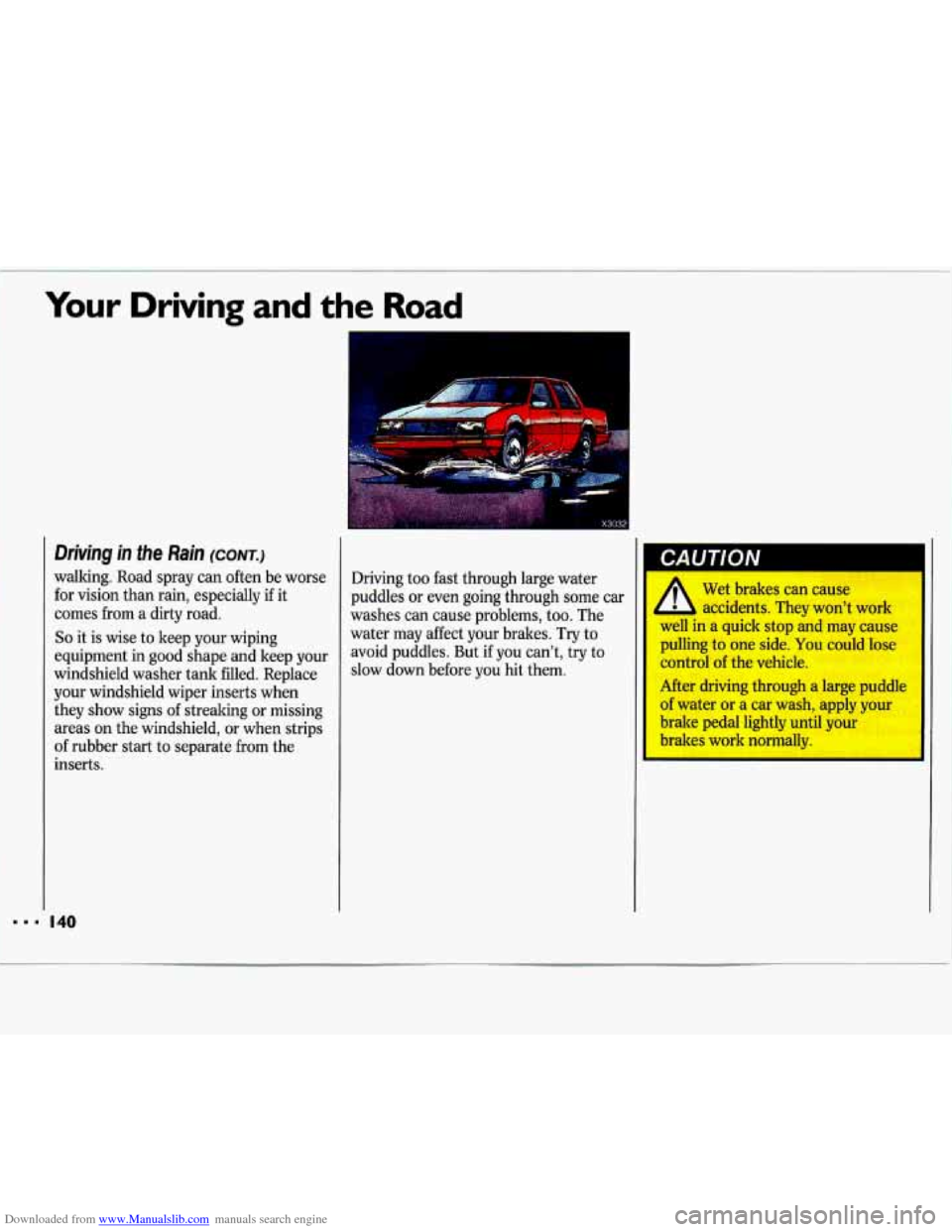
Downloaded from www.Manualslib.com manuals search engine ..I
Your Driving and the Road
Driving in the Rain (cow.)
walking. Road spray can often be worse for vision than rain, especially
if it
comes from
a dirty road.
So it is wise to keep your wiping
equipment in good shape and keep your
windshield washer tank filled. Replace
your windshield wiper inserts when
they show signs of streaking or missing
areas on the windshield, or when strips
of rubber start to separate from the
inserts.
I40
CAUTION
Driving too fast through large water
puddles or even going through some car
washes can cause problems, too. The
water may affect your brakes.
Try to
avoid puddles. But
if you can’t, try to
slow down before
you hit them.
A Wet brakes can cause
,- accidents. They won’t work
well in
a quick stop and may cause
pulling to one side.
You could lose
control
of the vehicle.
After driving through a large puddle of water or a car wash, apply your
brake pedal lightly until your
brakes work normally.
I
Page 150 of 324
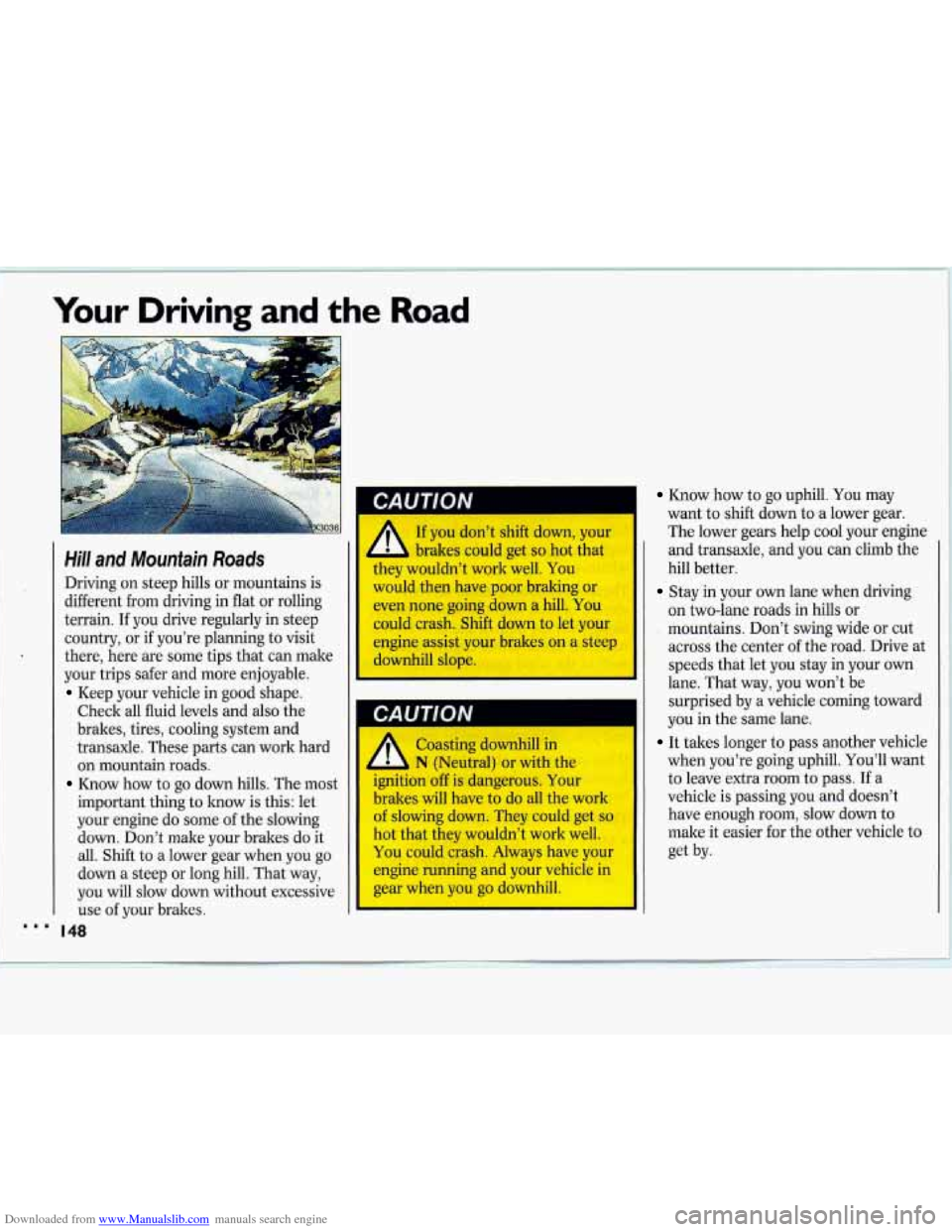
Downloaded from www.Manualslib.com manuals search engine Your Driving and the Road
CAUTION
Hill and Mountain Roads
Driving on steep hills or mountains is
different
from driving in flat or rolling
terrain. If you drive regularly in steep
country, or if you’re planning to visit
there, here are some tips that can make
your trips safer and more enjoyable.
Keep your vehicle in good shape.
Check all fluid levels and also the
brakes, tires, cooling system and
transaxle. These parts can work hard
on mountain roads.
Know how to go down hills. The most
important thing to know is this: let
your engine do some of the slowing
down. Don’t make your brakes do it
all. Shift to a lower gear when you go
down a steep or long hill. That way,
you will slow down without excessive
use of your brakes.
I48
A
If you don’t shift down, your
brakes could get
so hot that
they wouldn’t work well.
You
would then have poor braking or even none going down a hill. You could crash. Shift down to let your
engine assist your brakes on a steep
I downhill slope.
Know how to go uphill. You may
want to shift down to a lower gear.
The lower gears help
cool your engine
and transaxle, and you can climb the
hill better.
Stay in your own lane when driving
on two-lane roads in hills or
mountains. Don’t swing wide or cut
across the center of the road. Drive
at
speeds that let you stay in your own
lane. That way, you won’t be surprised by a vehicle coming toward
you in the same lane.
Coasting downhill in
11 It takes longer to pass another vehicle
N (Neutral) or with the when you’re going uphill. You’ll want
ignition off is dangerous. Your to leave extra room to pass.
If a
brakes will have to do all the work vehicle is passing you and doesn’t
of slowing down. They could get so have enough room, slow down to
hot that they wouldn’t work well. make it easier for the other vehicle to
You could crash. Always have your get by.
engine running and your vehicle in
gear when you go downhill.
i
Page 154 of 324
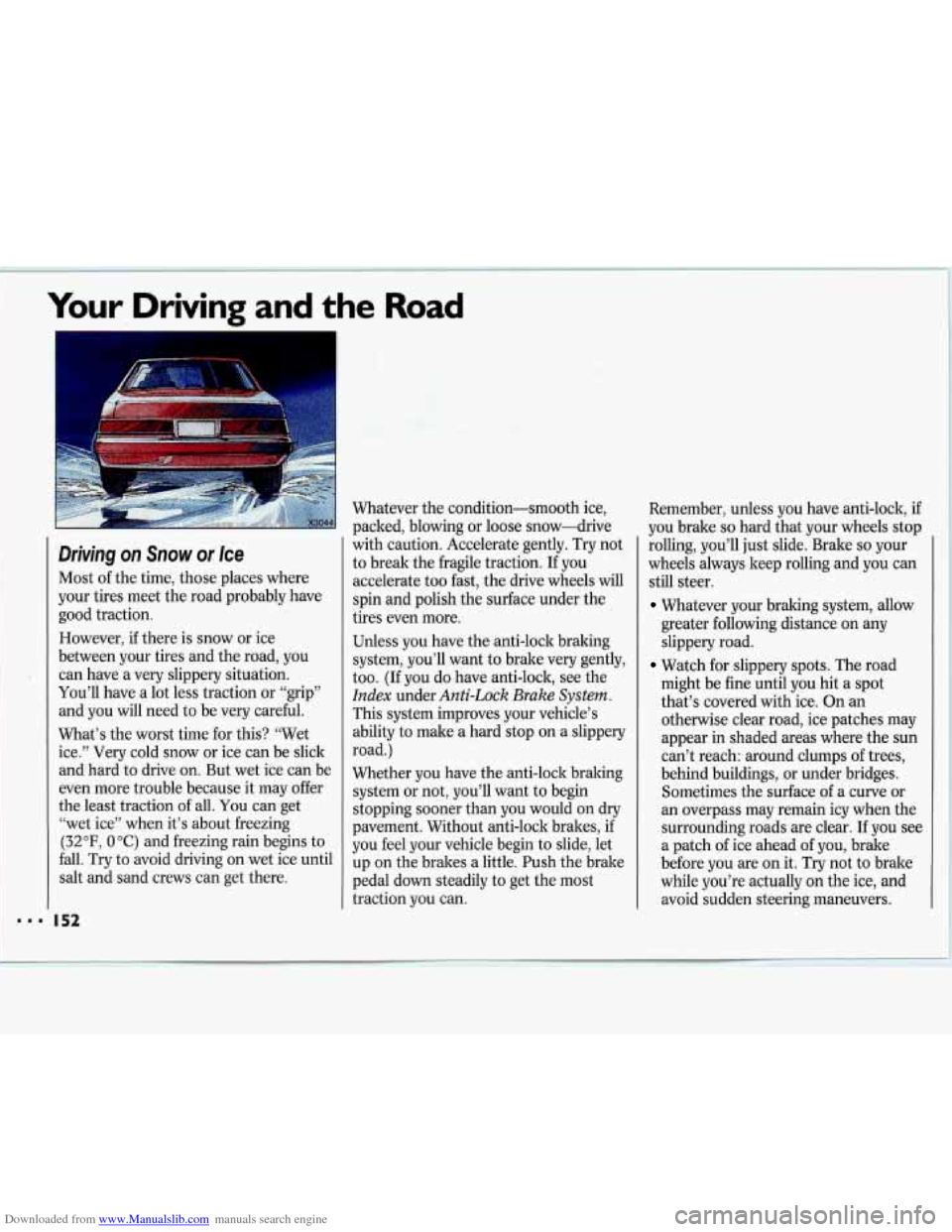
Downloaded from www.Manualslib.com manuals search engine Your Driving and the Road
Driving on Snow or Ice
Most of the time, those places where
your tires meet the road probably have
good traction.
However, if there is snow or ice
between your tires and the road, you
can have a very slippery situation.
You’ll have a lot less traction or “grip”
and you will need to be very careful.
What’s the worst time for this? “Wet
ice.” Very cold snow or ice can be slick
and hard to drive on. But wet ice can be
even more trouble because it may offer
the least traction of all. You can get
“wet ice” when it’s about freezing
(32°F’ 0 “C) and freezing rain begins to
fall. Try to avoid driving on wet ice until
salt and sand crews can get there. Whatever
the condition-smooth ice,
packed, blowing or loose snow-drive
with caution. Accelerate gently. Try not
to break the fragile traction. If you
accelerate too fast, the drive wheels will
spin and polish the surface under the
tires even more.
Unless you have the anti-lock braking
system, you’ll want to brake very gently,
too. (If you do have anti-lock, see the
Index under Anti-Lock Brake System.
This system improves your vehicle’s
ability to make a hard stop on a slippery
road.)
Whether you have the anti-lock braking
system or not, you’ll want to begin
stopping sooner than you would on dry
pavement. Without anti-lock brakes,
if
you feel your vehicle begin to slide, let
up on the brakes a little. Push the brake
pedal down steadily to get the most
traction you can. Remember, unless you have anti-lock,
if
you brake
so hard that your wheels stop
rolling, you’ll just slide. Brake
so your
wheels always keep rolling and you can
still steer.
Whatever your braking system, allow greater following distance on any
slippery road.
Watch for slippery spots. The road
might be fine until you hit a spot
that’s covered with ice. On an
otherwise clear road, ice patches may
appear in shaded areas where the sun
can’t reach: around clumps
of trees,
behind buildings, or under bridges.
Sometimes the surface of
a curve or
an overpass may remain icy when the
surrounding roads are clear. If you see
a patch of ice ahead of you, brake
before you are on it. Try not to brake
while you’re actually on the ice, and
avoid sudden steering maneuvers.
Page 156 of 324
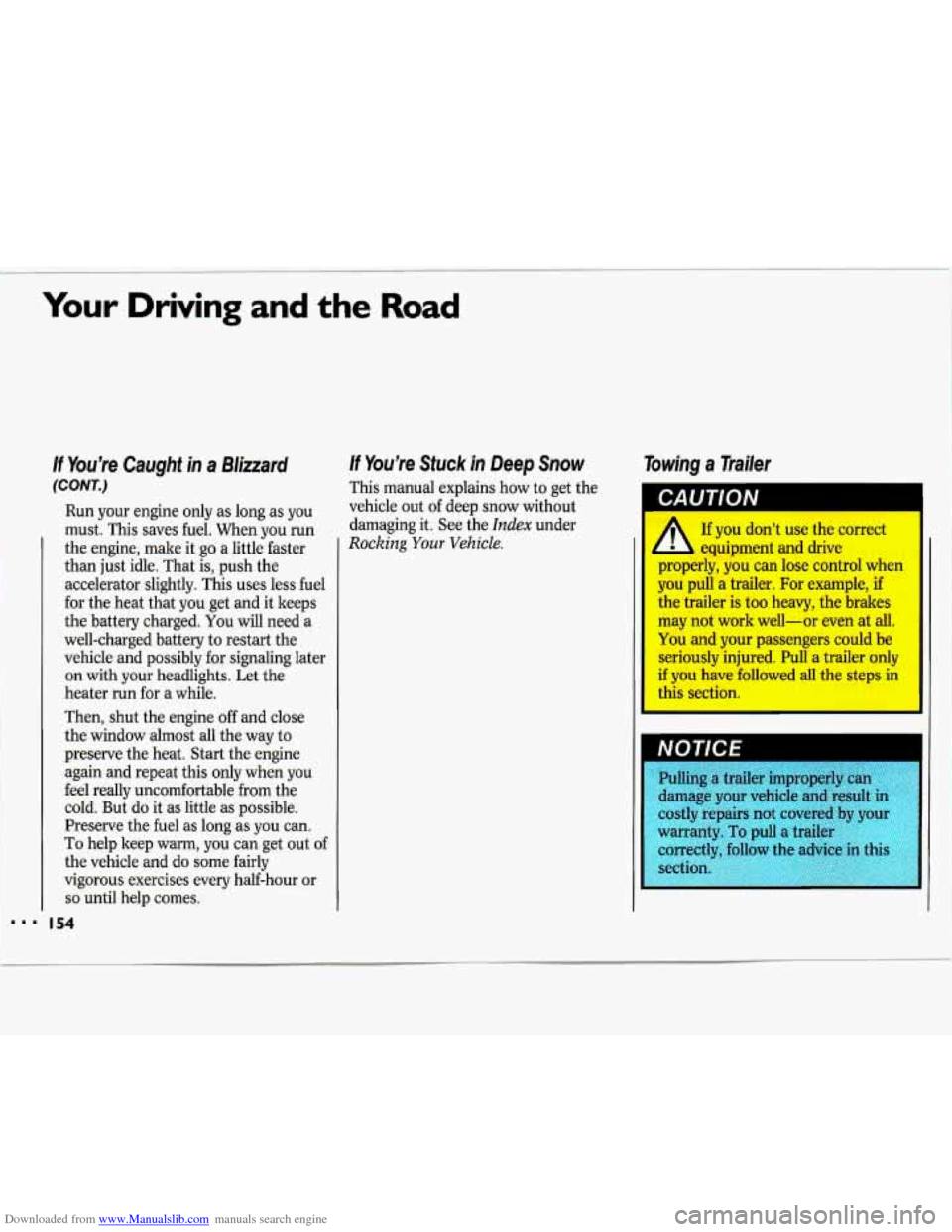
Downloaded from www.Manualslib.com manuals search engine Your Driving and the Road
I
If You’re Caught in a Blizzard
(CONT.)
Run your engine only as long as you
must. This saves fuel. When you run
the engine, make it go a little faster
than just idle. That is, push the
accelerator slightly. This uses less fuel
for the heat that you get and it keeps
the battery charged.
You will need a
well-charged battery to restart the
vehicle and possibly for signaling later
on with your headlights. Let the
heater run for a while.
Then, shut the engine
off and close
the window almost all the way to
preserve the heat. Start the engine
again and repeat this only when you
feel really uncomfortable from the
cold. But do it as little as possible.
Preserve the fuel as long as you can.
To help keep warm, you can get out of
the vehicle and do some fairly
vigorous exercises every half-hour or
so until help comes.
I54
If You’re Stuck in Deep Snow
This manual explains how to get the
vehicle out of deep snow without
damaging it. See the
Index under
Rocking Your Vehicle.
Towing a Trailer
II
CAUTION I
L
p.,gerly, you can lose control when
you pull a trailer. For example, if
the trailer is too heavy, the brakes
may not work well-or even at
all.
You and your passengers could be
seriously injured. Pull a trailer only
if you have followed all the steps in
this section.
L
railer improperly car
amage your vehicle and result in
costly repairs not covered by your
--
warranty. To pull a trailer
correctly, follow the advice
in this
__
Page 160 of 324
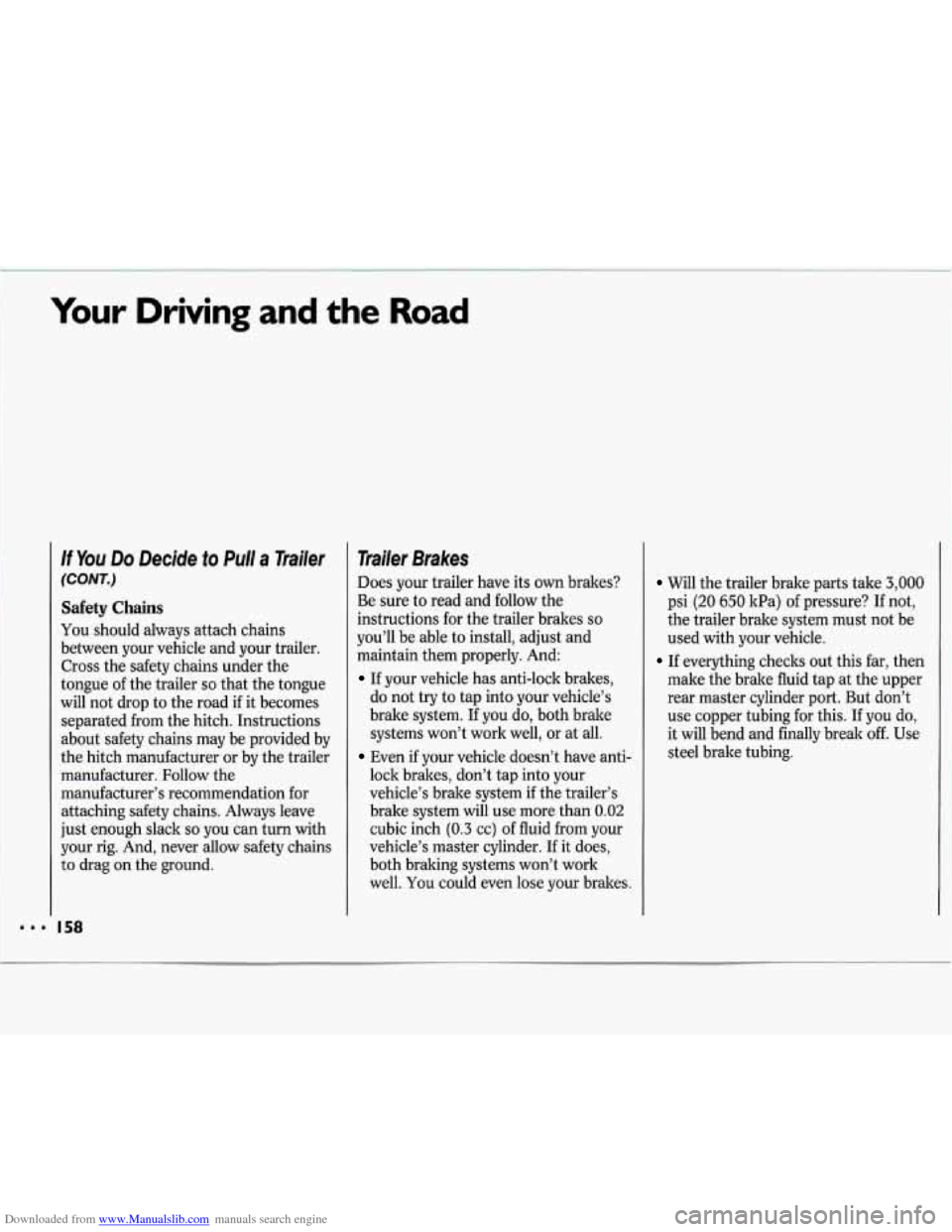
Downloaded from www.Manualslib.com manuals search engine Your Driving and the Road
If You Do Decide to Pull a Trailer
(CONT.)
Safety Chains
You should always attach chains
between your vehicle and your trailer.
Cross the safety chains under the
tongue of the trailer
so that the tongue
will not drop to the road if it becomes
separated from the hitch. Instructions
about safety chains may be provided by
the hitch manufacturer or by the trailer
manufacturer. Follow the
manufacturer’s recommendation for
attaching safety chains. Always leave
just enough slack
so you can turn with
your rig. And, never allow safety chains to drag on the ground.
Trailer Brakes
Does your trailer have its own brakes?
Be sure to read and follow the
instructions for the trailer brakes
so
you’ll be able to install, adjust and
maintain them properly. And:
If your vehicle has anti-lock brakes,
do not
try to tap into your vehicle’s
brake system. If you do, both brake
systems won’t work well, or at all.
Even if your vehicle doesn’t have anti-
lock brakes, don’t tap into your
vehicle’s brake system
if the trailer’s
brake system will use more than
0.02
cubic inch (0.3 cc) of fluid from your
vehicle’s master cylinder. If it does,
both braking systems won’t work
well.
You could even lose your brakes.
Will the trailer brake parts take 3,000
psi (20 650 kPa) of pressure? If not,
the trailer brake system must not be
used with your vehicle.
If everything checks out this far, then
make the brake fluid tap at the upper
rear master cylinder port. But don’t
use copper tubing for this. If you do,
it will bend and finally break
off. Use
steel brake tubing.
Page 161 of 324

Downloaded from www.Manualslib.com manuals search engine Driving with a Trailer
Towing a trailer requires a certain
amount of experience. Before setting out for the open road, you’ll want to get
to know your rig. Acquaint yourself
with the feel of handling and braking
with the added weight of the trailer.
And always keep in mind that the
vehicle you are driving is now
a good
deal longer and not nearly
so responsive
as your vehicle is by itself.
Before you start, check the trailer hitch
and platform, safety chains, electrical connector, lights, tires and mirror
adjustment. If the trailer has electric
brakes, start your vehicle and trailer
moving and then apply the trailer brake
controller by hand to be sure the brakes
are worling. This lets you check your
electrical connection at the same time. During your
trip, check occasionally to
be sure that the load is secure, and that
the lights and any trailer brakes are still
working.
Following Distance
Stay at least twice as far behind the
vehicle ahead
as you would when
driving your vehicle without a trailer.
This can help you avoid situations that
require heavy braking and sudden
turns.
Passing
You’ll need more passing distance up
ahead when you’re towing a trailer.
And, because you’re a good deal longer,
you’ll need to go much farther beyond
the passed vehicle before you can return
to your lane.
Backing Up
Hold the bottom of the steering wheel
with one hand. Then, to move the
trailer to the left, just move that hand
to
the left. To move the trailer to the right,
move your hand to the right. Always
back up slowly and, if possible, have
someone guide you.
Page 162 of 324

Downloaded from www.Manualslib.com manuals search engine Your Driving and the Road
Driving with a Trailer (CONT.)
Making Turns
When you’re turning with a trailer, make wider turns than normal. Do this
so your trailer won’t strike soft
shoulders, curbs, road signs, trees, or
other objects. Avoid jerky or sudden
maneuvers. Signal well in advance.
Turn Signals When Towing a Trailer
When you tow a trailer, your vehicle has
to have a different turn signal flasher
and extra wiring. The green arrows on
your instrument panel will flash
whenever you signal a turn or lane
change. Properly hooked up, the trailer
lights will also flash, telling other
drivers you’re about to turn, change
lanes or stop.
I60
When towing a trailer, the green arrows
on your instrument panel will flash for
turns even if the bulbs on the trailer are
burned out. Thus, you may think
drivers behind you are seeing your
signal when they are not. It’s important
to check occasionally to be sure the
trailer bulbs are still working.
Your vehicle has bulb warning .lights.
When you plug trailer lights into your
vehicle’s lighting system, its bulb
warning lights may not let you know if
one
of your lights goes out. So, when
you have trailer lights plugged in, be
sure to check your vehicle and trailer
lights from time to time to be sure
they’re all working. Once you disconnect the trailer lights, the bulb
warning lights again can tell you if one
of your vehicle lights
is out.
Driving On Grades
Reduce speed and shift to a lower gear
before you start down a long or steep
downgrade. If you don’t shift down,
you
might have to use your brakes so much
that they would get hot and no longer
work well.
On a long uphill grade, shift down and
reduce your speed to around
45 mph
(70 Wh) to reduce the possibility of
engine and transaxle overheating.
If you are towing a trailer and you have
an automatic transaxle with Overdrive,
it’s best to drive in
D instead of (or,
as you need to, a lower gear). This will
minimize heat build-up and extend the
life of your transaxle.